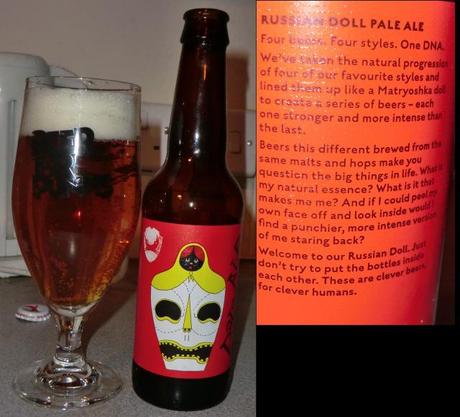
Brewdog: Russian Doll: Pale Ale (Scotland: American Pale Ale: 4% ABV)
Visual: Pale gold. Moderate tight bubbles white head that rises to a froth. Low carbonation.
Nose: Biscuity. Light resin. Custard cream biscuits. Light pineapple. Crisp hops.
Body: Nettles. Dry cardboard malt. Simple bitterness. Sherbety feel. Dry. Kumquat. Light fruit sugar sweetness. Pineapple.
Finish: Slight charring and bitterness. White wine dryness. Pineapple.
Conclusion: Hmm, not a good start for this series. Now, this could just be me and American Pale Ales, they can be a hard sell for me unless well done. However this, like quite a few APAs, feels too heavily attenuated for me. As the lowest malt expression of the Russian Doll series, the sweetness is very reined in, which creates a very dry beer. It causes the hops to come in as feel mainly, rather than flavor – with just a bitter prickle against an almost cardboard dry background. It just doesn’t seem to have the grip to deliver flavor with it.
For me, the American Pale Ale can be done well, but they seem much harder to balance than, say, IPAs, and this has to struggle against a generic recipe that has been designed to scale up and down. As such it seems it couldn’t be tailored to APAs stronger aspects. Here and now, I have to take a large swig of this beer to even get a little of the fruit sugar sweetness and flavor.
Overall it actually feels dull, there is no spark of zest. There are some flavours swimming around mid body but badly defined. Unlike the aroma, which is the strong point of the beer – while it is not wide ranging it is a few notes delivered well. Unfortunately all that lasts into the mid body is a weak call to pineapple tartness, that admittedly does rise over time, but never really becomes what it needs to be. On the bigger mouthfuls you definitely get some, but, again, the beer feels too dry for me. The flavours then come in too flat because of that.
An unfortunately weak effort.
Background: Nice idea here, four beers – same recipe, with the exception that more malt is used in each style, from pale ale, through IPA, IIPA, to Barley Wine – thus showing how the interactions with the other elements change. As always I am not an unbiased actor on Brewdog beers.

